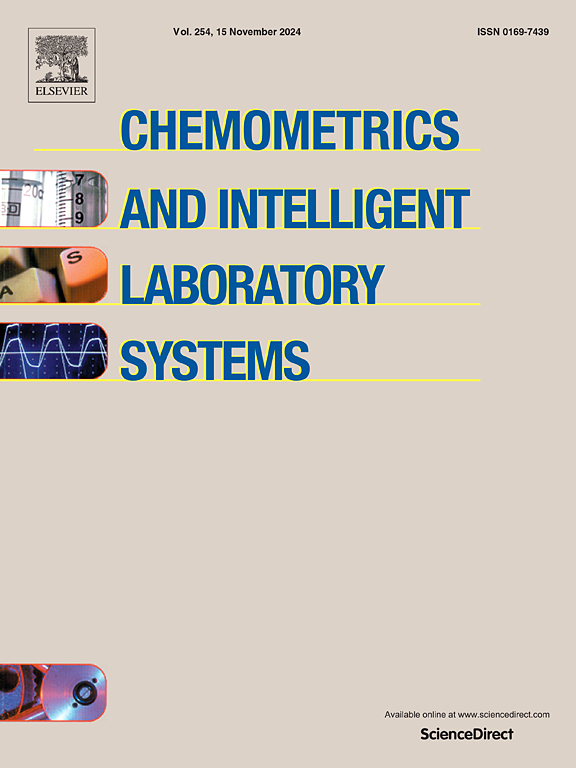Integration of multifactorial omics data from several sources using multiblock methods
IF 3.8
2区 化学
Q2 AUTOMATION & CONTROL SYSTEMS
Chemometrics and Intelligent Laboratory Systems
Pub Date : 2025-04-14
DOI:10.1016/j.chemolab.2025.105403
引用次数: 0
Abstract
With advances in data acquisition methods and technical platforms, omics measurement collection yields increasingly complex data structures. While high-dimensional matrices with more variables than samples can be handled via multivariate methods, extracting information is more challenging in the case of experimental designs involving several factors. Multifactorial models combining ANOVA and multivariate approaches have been developed for this purpose, but analyzing unbalanced designs remains challenging, especially when several data blocks are integrated.
This study introduces integrative AComDim (iAComDim) and integrative AMOPLS (iAMOPLS) for the analysis of multifactorial data from multiple sources. These methods implement a rebalancing strategy tailored for multiblock settings, ensuring unbiased effect estimators and orthogonal effect matrices even with unbalanced designs. When applied to a multiomics benchmark dataset with two experimental factors, these approaches effectively separate the sources of variation related to the effects in the design while summarizing information into a single multiblock model. Rebalancing strategies prevent the mixing of variation sources in extracted components, and their integration with multiblock chemometric methods offers an efficient and versatile solution for analyzing complex data structures.
This work establishes a novel framework for analyzing data from single or multiple sources within multifactorial experimental designs. Furthermore, the proposed methods are flexible enough to analyze unbalanced designs with heterogeneously missing replicates across multiple tables, making them broadly applicable for handling multiomics or other datasets in various application domains.
使用多块方法集成来自多个来源的多因子组学数据
随着数据采集方法和技术平台的进步,组学测量采集产生的数据结构越来越复杂。虽然变量多于样本的高维矩阵可以通过多变量方法处理,但在涉及多个因素的实验设计的情况下,提取信息更具挑战性。结合方差分析和多变量方法的多因素模型已经为此目的而开发,但分析不平衡设计仍然具有挑战性,特别是当多个数据块集成时。本研究引入综合AComDim (iAComDim)和综合AMOPLS (iAMOPLS)对多源多因子数据进行分析。这些方法实现了为多块设置量身定制的再平衡策略,即使在不平衡设计中也能确保无偏效应估计器和正交效应矩阵。当应用于具有两个实验因素的多组学基准数据集时,这些方法有效地分离了与设计效果相关的变异源,同时将信息汇总到单个多块模型中。再平衡策略防止了提取成分中变异源的混合,并与多块化学计量方法相结合,为分析复杂数据结构提供了一种高效、通用的解决方案。这项工作建立了一个新的框架,用于分析多因素实验设计中来自单一或多个来源的数据。此外,所提出的方法具有足够的灵活性,可以分析跨多个表的异构缺失复制的不平衡设计,使其广泛适用于处理各种应用领域的多组学或其他数据集。
本文章由计算机程序翻译,如有差异,请以英文原文为准。
求助全文
约1分钟内获得全文
求助全文
来源期刊
CiteScore
7.50
自引率
7.70%
发文量
169
审稿时长
3.4 months
期刊介绍:
Chemometrics and Intelligent Laboratory Systems publishes original research papers, short communications, reviews, tutorials and Original Software Publications reporting on development of novel statistical, mathematical, or computer techniques in Chemistry and related disciplines.
Chemometrics is the chemical discipline that uses mathematical and statistical methods to design or select optimal procedures and experiments, and to provide maximum chemical information by analysing chemical data.
The journal deals with the following topics:
1) Development of new statistical, mathematical and chemometrical methods for Chemistry and related fields (Environmental Chemistry, Biochemistry, Toxicology, System Biology, -Omics, etc.)
2) Novel applications of chemometrics to all branches of Chemistry and related fields (typical domains of interest are: process data analysis, experimental design, data mining, signal processing, supervised modelling, decision making, robust statistics, mixture analysis, multivariate calibration etc.) Routine applications of established chemometrical techniques will not be considered.
3) Development of new software that provides novel tools or truly advances the use of chemometrical methods.
4) Well characterized data sets to test performance for the new methods and software.
The journal complies with International Committee of Medical Journal Editors'' Uniform requirements for manuscripts.

 求助内容:
求助内容: 应助结果提醒方式:
应助结果提醒方式:


